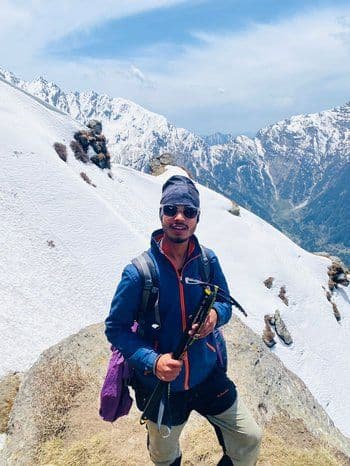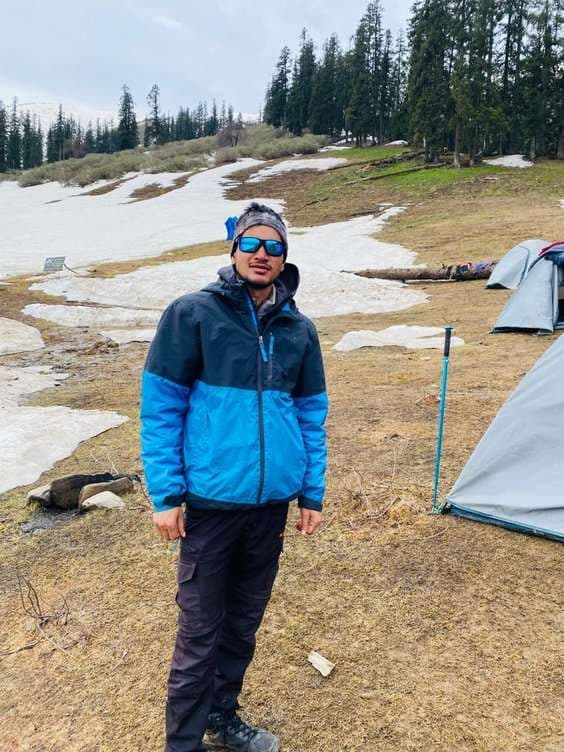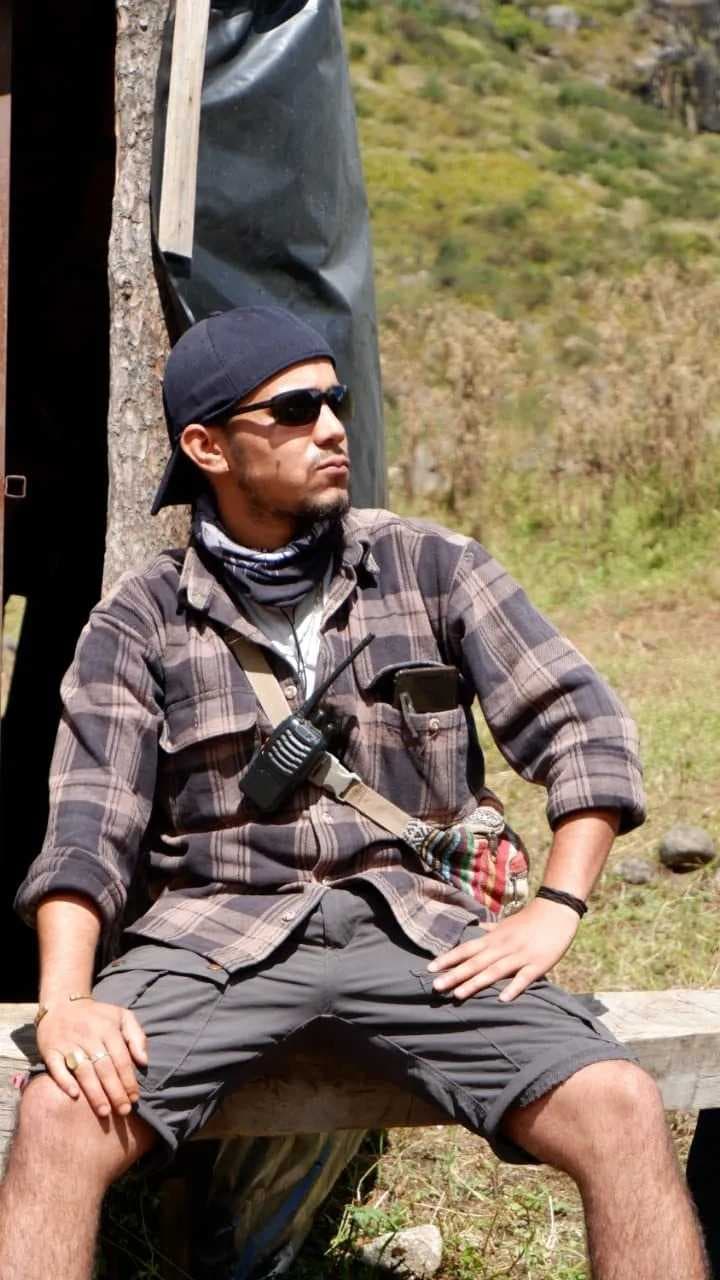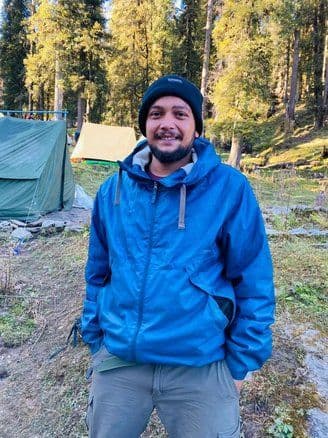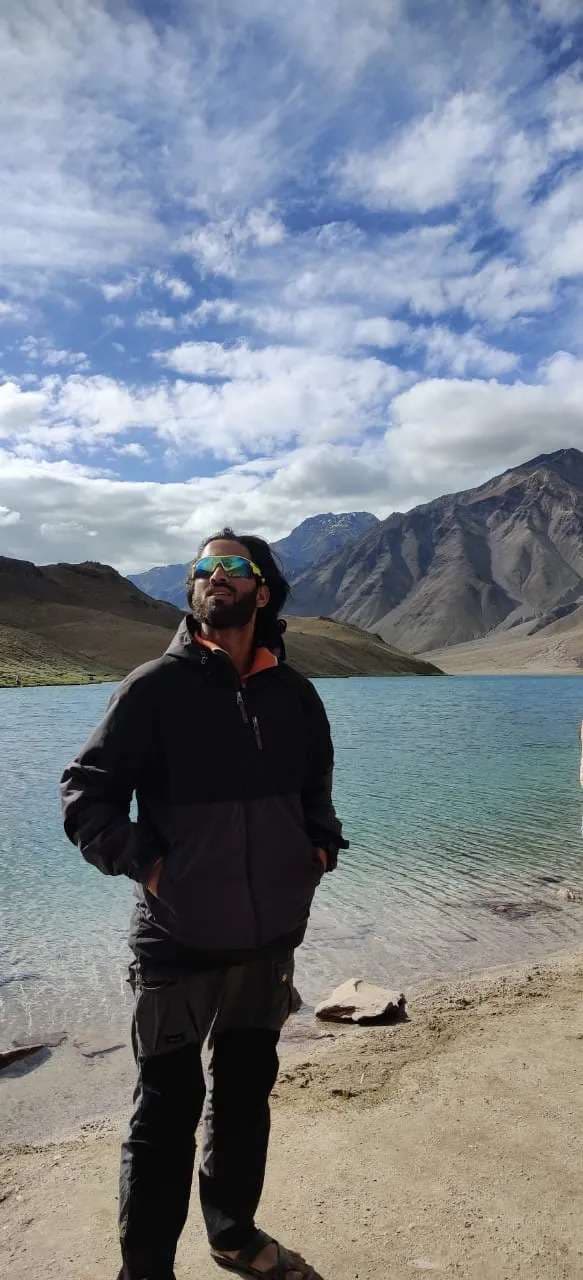Mount Meru is a prominent peak in the Garhwal Himalayas of Uttarakhand, India. It is often confused with another peak of the same name in Tanzania, but this Mount Meru is distinct and located in the Indian Himalayas. Mount Meru is part of the Gangotri Group of peaks, which includes several significant mountains in the Garhwal region of Uttarakhand. It is situated near the holy town of Gangotri and is located within the Uttarkashi district. The peak stands at an elevation of approximately 6,672 meters (21,890 feet) above sea level.
Mount Meru is known for its challenging climbs and has attracted mountaineers from around the world. The first successful ascent of Mount Meru was made by a team of Conrad Anker's successful ascent of Mount Meru in 2012, along with Jimmy Chin and Renan Ozturk. Mount Meru is indeed known for its challenging climbs, and their successful expedition is a testament to their mountaineering skills and determination. Climbing this peak requires exceptional technical proficiency and the ability to overcome the physical and mental challenges that high-altitude mountaineering presents. It's an achievement that is celebrated in the mountaineering community. Since then, the peak has seen numerous successful ascents by various climbing teams.
Climbing Mount Meru typically involves a combination of ice, snow, and technical climbing. The popular route to the summit is the northwest ridge. Climbers often face technical challenges and unpredictable weather conditions during the ascent.
Mount Meru, like other peaks in the region, holds cultural and spiritual significance for the people of India. The Gangotri region is known for its sacred temples and pilgrimage sites.
Climbing Mount Meru is a demanding endeavor due to its high altitude and the challenging terrain. Climbers must be well-prepared, acclimatized, and possess technical climbing skills before attempting the ascent.
The entire Garhwal region, including Mount Meru, falls within the protected areas of the Nanda Devi Biosphere Reserve. Conservation efforts are in place to protect the unique flora and fauna of the region.
Best Time For Mount Meru Expedition
The best time to visit Mount Meru in the Garhwal Himalayas of Uttarakhand, India, largely depends on your specific objectives and preferences. However, the most favorable time for a Mount Meru expedition is during the pre-monsoon (spring) and post-monsoon (autumn) seasons. Here are the recommended timeframes:
1. Pre-Monsoon Season (Spring):
Best Months: April to June
Mild temperatures during the day, making trekking and climbing more comfortable.
Clear skies and excellent visibility for taking in the breathtaking views.
Wildflowers in full bloom, adding beauty to the landscape.
Suitable for those who prefer milder weather conditions.
2. Post-Monsoon Season (Autumn):
Best Months: September to November
Stable weather with minimal rainfall and reduced risk of landslides.
Crisp and clear days for trekking and climbing.
Spectacular views of the surrounding peaks and landscapes.
Comfortable temperatures during the day.
It's important to note that the monsoon season in the Himalayas, which typically occurs from July to August, can bring heavy rainfall and adverse conditions, making it less suitable for expeditions. During this time, the trails can be slippery, and there may be a higher risk of landslides.
Winter months (December to February) are also not recommended for Mount Meru expeditions due to extreme cold, heavy snowfall, and the potential for avalanches and challenging climbing conditions.
Before planning your trip, it's advisable to check weather forecasts and local conditions for the specific year you intend to visit. Additionally, consult with experienced mountaineers, expedition organizers, or guides who have knowledge of the region to ensure that your expedition aligns with the optimal time for safety and enjoyment.
How To Reach Dehradun
Reaching Dehradun, the capital city of the Indian state of Uttarakhand, can be done through various modes of transportation, including by air, train, or road. Here are the common ways to reach Dehradun:
By Air:-
Jolly Grant Airport (DED): The nearest airport to Dehradun is Jolly Grant Airport, which is approximately 30 kilometers (about 19 miles) away from the city center. It is a domestic airport and operates regular flights from major Indian cities like Delhi, Mumbai, and Bangalore. From the airport, you can take a taxi or a pre-booked car to reach Dehradun city.
By Train:-
Dehradun Railway Station: Dehradun has its own railway station, Dehradun Railway Station (DDN), which is well-connected to various cities in India. Frequent trains operate to and from Delhi, Kolkata, Mumbai, and other major cities. The railway station is located in the heart of the city, making it convenient for travelers to reach their destination.
By Road:-
Road Network: Dehradun is well-connected by road to various cities and towns in northern India. The city is accessible via National Highway 7 (NH7) and National Highway 72 (NH72). You can reach Dehradun by bus, taxi, or your own vehicle. Several private and state-run bus services operate from Delhi, Chandigarh, and other nearby cities to Dehradun.
If you're traveling from Delhi, which is a common starting point for many travelers to Dehradun, here are some additional details:
By Air from Delhi: You can book a flight from Indira Gandhi International Airport (DEL) in Delhi to Jolly Grant Airport (DED) in Dehradun. The flight duration is approximately 1 to 1.5 hours.
By Train from Delhi: There are several trains from New Delhi Railway Station (NDLS) and Old Delhi Railway Station (DLI) to Dehradun Railway Station (DDN). The train journey takes around 5 to 7 hours.
By Road from Delhi: You can also drive or take a bus from Delhi to Dehradun, which is approximately 250 to 300 kilometers (155 to 186 miles) and takes around 5 to 7 hours, depending on the route and traffic conditions.
Please check the latest travel information and availability of transportation options before planning your trip to Dehradun, as schedules and routes may vary.
Difficulty Level Of Mount Meru expedition
The difficulty level of a Mount Meru expedition can vary depending on the route chosen. There are two main routes for climbing Mount Meru: the Momella route and the Socialist Peak route. Each route has its own challenges, and the overall difficulty is influenced by factors such as altitude, terrain, and weather conditions.
Momella Route:
Difficulty: The Momella route is considered the easier of the two routes. It typically takes about 3-4 days to reach the summit.
Terrain: The trail passes through lush forests, open grasslands, and rocky sections. The ascent is gradual in the initial stages.
Altitude: While altitude sickness is a concern, the gradual ascent helps in acclimatization.
Socialist Peak Route:
Difficulty: The Socialist Peak route is more challenging and is recommended for experienced trekkers. It is a longer route, usually taking around 4-5 days to reach the summit.
Terrain: This route involves steeper and more rugged terrain, with some technical sections requiring scrambling.
Altitude: As with any high-altitude climb, acclimatization is crucial to minimize the risk of altitude-related issues.
Overall Considerations:
Altitude: Mount Meru's summit stands at around 4,562 meters (14,967 feet), and altitude sickness is a concern. Adequate acclimatization is essential.
Weather: Weather conditions can change rapidly, and temperatures can drop significantly, especially at higher altitudes. Proper gear is crucial.
Fitness Level: A good level of fitness is important for both routes, but the Socialist Peak route demands a higher level of physical fitness and endurance.
It's important for trekkers to be well-prepared, physically fit, and equipped with the right gear. Additionally, hiring an experienced guide and following safety protocols are crucial for a successful and safe expedition. Always check the latest information and consult with local experts to plan a trek that suits your group's abilities and preferences.
Things To Carry For Mount Meru Expedition
When preparing for a Mount Meru expedition, it's crucial to pack carefully to ensure you have all the necessary gear for a safe and enjoyable trek. Here's a comprehensive list of items you should consider bringing:
Clothing:
Moisture-Wicking Base Layers: Long-sleeved shirts, Long pants
Insulating Layers: Fleece or down jacket, Insulated pants
Outer Shell: Waterproof and windproof jacket, Waterproof and windproof pants
Headwear: Warm hat, Sun hat with a brim, Bandana or buff
Handwear: Insulated gloves, Liner gloves
Footwear: Waterproof and sturdy trekking boots, Gaiters (to keep snow and debris out of boots), Extra pair of comfortable camp shoes
Equipment:
Backpack: Large enough to carry your essentials
Sleeping Bag: Rated for cold temperatures
Sleeping Pad: Insulated for added warmth
Trekking Poles: Adjustable and sturdy
Headlamp/Flashlight: With extra batteries
Water Bottles/Hydration System: Ensure you stay hydrated at high altitudes
Snacks: High-energy snacks like trail mix and energy bars
Sun Protection: Sunscreen with high SPF, Lip balm with UV protection, Sunglasses with UV protection
Climbing Gear (if applicable):
Helmet: Especially for routes involving technical sections
Harness: If roped climbing is involved
Crampons: If encountering icy or snowy conditions
Ice Axe: Necessary for certain routes
Personal Items:
First Aid Kit: Including any necessary prescription medications
Toiletries: Toothbrush, toothpaste, biodegradable soap, etc.
Trekking Permit and Documentation: Ensure all necessary permits are secured
Camera: To capture the breathtaking views
Power Bank: Keep electronic devices charged
Map and Compass/GPS: Know your route and have navigation tools
Multi-tool/Knife: Useful for various tasks
Duct Tape: Handy for quick repairs
Remember, this list is a general guide, and specific items may vary based on the season, route, and individual preferences. Always check the weather conditions and consult with experienced guides to ensure you're adequately prepared for the unique challenges of Mount Meru.
How To Prepare For Mount Meru Expedition
Preparing for a Mount Meru expedition, like any high-altitude mountaineering adventure in the Himalayas, requires careful planning, physical fitness, technical skills, and the right equipment. Here are the key steps to prepare for a Mount Meru expedition:
1. Physical Fitness:
Build your cardiovascular endurance with activities like running, hiking, and cycling.
Strengthen your core, legs, and upper body through weight training and bodyweight exercises.
Practice endurance training to prepare for long days of climbing.
2. High-Altitude Acclimatization:
Spend time at higher altitudes to acclimatize your body to reduced oxygen levels. Gradual acclimatization is essential to prevent altitude sickness.
Consider participating in shorter high-altitude treks or climbs before attempting Narayan Parbat.
3. Technical Climbing Skills:
Develop or improve your technical climbing skills, including ice and rock climbing, rope work, and crevasse rescue techniques.
Consider taking mountaineering courses or hiring a guide to enhance your skills.
4. Equipment and Gear:
Invest in high-quality mountaineering equipment, including crampons, ice axes, harnesses, ropes, and helmets.
Ensure your clothing is suitable for cold and high-altitude conditions, including down jackets, insulated pants, and moisture-wicking base layers.
Don't forget essential items like sleeping bags, tents, and cooking equipment for the expedition.
5. Navigation and Route Planning:
Study maps of the Mount Meruregion and familiarize yourself with potential climbing routes.
Create a detailed itinerary and share it with your team and expedition organizers.
Understand the terrain, potential hazards, and escape routes.
6. Team and Communication:
Assemble a skilled and experienced team of climbers and support staff.
Establish clear communication protocols, including the use of radios or satellite phones for emergency situations.
7. Permits and Logistics:
Obtain all necessary permits for the expedition, which may include permits for the national park and local authorities.
Arrange logistics such as transportation to the base camp, food supplies, and accommodation.
8. Health and Safety:
Undergo a thorough medical check-up to ensure you are physically fit for high-altitude climbing.
Pack a comprehensive first-aid kit and medications for altitude sickness and other potential ailments.
Develop a comprehensive emergency response plan.
9. Environmental Awareness:
Practice Leave No Trace principles to minimize your impact on the environment.
Respect local customs and traditions, and adhere to ethical climbing practices.
10. Weather Monitoring:
Stay updated on weather forecasts for the region and be prepared for rapid weather changes in the mountains.
Adjust your climbing schedule based on weather conditions.
11. Training Expeditions:
Consider undertaking training expeditions to lesser-known peaks in the Himalayas to gain experience and assess your readiness for Narayan Parbat.
12. Mental Preparation:
Mentally prepare for the challenges of high-altitude climbing, including fatigue, extreme cold, and exposure to risk.
Maintain a positive mindset and practice resilience in challenging situations.
Always prioritize safety during your Mount Meru expedition, and be prepared to turn back if conditions become too dangerous. Consult with experienced mountaineers or expedition organizers for guidance and support throughout the preparation process.
Safety Factors Of Mount Meru Expedition
Safety is paramount during a Mount Meru expedition, given the challenging high-altitude conditions and the potential risks associated with mountaineering. Here are some key safety factors to consider when planning and executing your expedition:
1. Experienced Team: Assemble a team of experienced climbers and support staff who are familiar with high-altitude mountaineering and the specific challenges of Narayan Parbat.
2. Pre-expedition Medical Check-up: Ensure that all team members undergo a thorough medical check-up to assess their physical fitness for high-altitude climbing. Address any health concerns before the expedition.
3. Acclimatization: Allocate sufficient time for acclimatization to reduce the risk of altitude sickness. Gradual ascent and rest days at higher elevations are crucial.
4. Weather Monitoring: Stay updated on weather forecasts for the region and be prepared for rapid weather changes. Adjust your climbing schedule based on weather conditions.
5. Emergency Communication: Carry communication devices such as satellite phones, radios, or personal locator beacons (PLBs) to call for help in case of emergencies.
6. Route Assessment: Conduct a thorough assessment of the climbing route, potential hazards, and escape routes. Be prepared to adapt your plans based on changing conditions.
7. Avalanche Safety: If the route involves avalanche-prone areas, carry and use appropriate avalanche safety gear, including beacons, probes, and shovels.
8. Climbing Rope and Harness: Use climbing ropes and harnesses when necessary for safety during technical climbs or glacier travel.
9. First-Aid Kit: Carry a comprehensive first-aid kit and ensure that team members are trained in basic first-aid and wilderness medicine.
10. Emergency Response Plan: Develop a detailed emergency response plan that includes procedures for injuries, altitude sickness, and evacuation. Share this plan with all team members.
11. High-Altitude Tents: Use high-altitude tents that are suitable for extreme cold to provide shelter and warmth during the expedition.
12. Food and Hydration: Ensure a steady supply of food and clean water to maintain energy levels and prevent dehydration and malnutrition.
13. Leave No Trace: Practice Leave No Trace principles to minimize your environmental impact on the mountain. Proper waste disposal is essential.
14. Climbing in Teams: Whenever possible, climb in teams with rope connections to provide support and reduce the risk of accidents.
15. Altitude and Frostbite Awareness: Educate team members about the symptoms of altitude sickness, frostbite, and other cold-related injuries. Monitor each other for signs of distress.
16. Communication and Check-Ins: Maintain regular communication with base camp or support teams. Establish check-in times and locations during the climb.
17. Decision-Making: Encourage a culture of open communication and mutual decision-making within the team. Be prepared to make difficult decisions, including turning back if conditions become unsafe.
18. Rescue Plan: Have a well-defined rescue plan in place, including contact information for local authorities or rescue services.
Remember that safety is a shared responsibility, and all team members should actively participate in risk assessment and safety procedures. Prioritize safety above all else, and be prepared to make conservative decisions to ensure the well-being of the team during your Mount Meru expedition.
